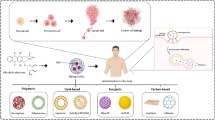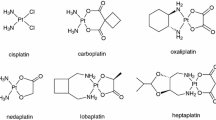Summary
Three stable mononuclear hematoporphyrin IX ((7,12-bis(1-hydroxyethyl)-3,8,13,17-tetramethyl-21H-23H-porphyn-2,18-dipropionic acid), Hp) complexes of PtIII, namely cis-[ PtIII(NH3)2(Hp−3H)(H2O)2].H2O 1, [PtIII(Hp−3H)(H2O)2].H2O 2 and [PtIII((O,O)Hp−2H)Cl(H2O)3] 3 with distorted octahedral structure and (dz2)1 ground state have been tested in vitro for antineoplastic activity in a panel of tumor cell lines. The novel platinum(III) complexes showed cytotoxic activity in a concentration-dependent manner with IC50 values comparable to those of referent cytotoxic agent cisplatin together with lower cytotoxicity against renal cells. Further detailed evaluation of the active analogue 2 and the less active complex 3 showed that their potency greatly correlates with the ability to induce apoptosis and to bind DNA. Despite the structural dissimilarities between complex 2 and cisplatin, their DNA-adducts were equally effectively recognized and repaired by the nucleotide excision repair system. Complex 2 showed quite superior ability to accumulate in K-562 cells relative to cisplatin.








Similar content being viewed by others
References
Boulikas T, Vougiouka M (2003) Cisplatin and platinum drugs at the molecular level. Oncol Rep 10:1663–1682
Canal PR (1998) Platinum coordination compounds pharmacokinetics and pharmaco-dynamics. In: Grochow LG, Ames MM (eds) A clinician’s guide to chemotherapy pharmacokinetics and pharmacodynamics. Williams and Willkins, Baltimore, pp 345–361
Bosl GJ, Motzer RJ (1997) Medical progress: testicular germ-cell cancer. New Engl J Med 337:242–254
Ozols RF, Young RC (1984) Chemotherapy of ovarian cancer. Semin Oncol 11:251–263
Galanski M, Jakupec MA, Keppler BK (2005) Update of the preclinical situation of anticancer platinum complexes: novel design strategies and innovative analytical approaches. Curr Med Chem 12:2075–2094
Desoize B (2004) Metals and metal compounds in cancer treatment. Anticancer Res 24:1529–1544
Cannistra SA (2004) Medical progress: cancer of the ovary. New Engl J Med 351:2519–2529
Hanigan MH, Devarajan P (2003) Cisplatin nephrotoxicity: molecular mechanisms. Canc Ther 1:47–61
Akiyama S-I, Chen Z-S, Sumizawa T, Furukawa T (1999) Resistance to cisplatin. Anticancer Drug Des 14:143–151
Chaney SG, Sancar A (1996) DNA repair: enzymatic mechanisms and relevance to drug response. J Natl Cancer Inst 88:1346–1360
Ota K (1996) Nedaplatin. Gan To Kagaku Ryoho 23:379–387
Reedijk J (1999) Medicinal applications of heavy-metal compounds. Curr Opin Chem Biol 3:236–240
Xin Zhang C, Lippard SJ (2003) New metal complexes as potential therapeutics. Curr Opin Chem Biol 7:481–489
Momekov G, Bakalova A, Karaivanova M (2005) Novel approaches towards development of non-classical platinum-based antineoplastic agents: design of platinum complexes characterized by an alternative DNA-binding pattern and/or tumor-targeted cytotoxicity. Curr Med Chem 12:2177–2191
Jakupec MA, Galanski M, Keppler BK (2003) Tumor-inhibiting platinum complexes-state of the art and future perspectives. Rev Physiol Biochem Pharmacol 146:1–54
Heffeter P, Jungwirth U, Jakupec M, Hartinger C, Galanski M, Elbling L et al (2008) Resistance against novel anticancer metal compounds: differences and similarities. Drug Resist Updat 11:1–16
Hall MD, Hambley TW (2002) Platinum(IV) antitumor compounds: their bioinorganic chemistry. Coord Chem Rev 232:49–67
Reisner E, Arion VB, Keppler BK, Pombeiro JL (2008) Electron-transfer activated metal-based anticancer drugs. Inorg Chim Acta 361:1569–1583
Momekov G, Momekova D (2006) Recent developments in antitumor platinum coordination compounds. Expert Opin Ther Pat 16:1383–1403
Bruijnincx PCA, Sadler PJ (2008) New trends for metal complexes with anticancer activity. Curr Opin Chem Biol 12:197–206
Davidson JP, Faber PJ, Fisher RG Jr, Mansy S, Peresie HJ, Rosenberg B et al (1975) “Platinum pyrimidine blues” and related complexes: a new class of potent antitumor agents. Cancer Chemother Rep 59:287–300
Lippert B (1999) Platinum blues: on the way toward unraveling a mystery. In: Lippert B (ed) Cisplatin: chemistry and biochemistry of a leading anticancer drug. Wiley-VCH, Weinheim, pp 379–405
Usón R, Fornies J, Tomás M, Menjón, B, Sünkel K, Bau R (1984) The first mononuclear Pt III complex. Molecular structures of (NBu4)[Pt III (C6Cl5)4] and of its parent compound {NBu4}2[Pt II (C6Cl5)4]·2CH2Cl2. J Chem Soc, Chem Commun 751–752. doi: 10.1039/C39840000751
Mitewa M, Gencheva G, Bobev S, Cochev G, Mehandjiev D, Wawer I (1999) Formation and stabilization of monomeric Pt(III) species through complexation with linear tetrapyrrole ligand bilirubin. Res Chem Intermed 25:431–439
Gencheva G, Tsekova D, Gochev G, Momekov G, Tyuliev G, Skumryev V, Karaivanova M, Bontchev PR (2007) Synthesis, structural characterization and cytotoxic activity of novel paramagnetic platinum hematoporphyrin IX complexes: potent antitumor agents. Metal-Based Drugs. doi:10.1155/2007/67376
Lottner C, Bart KC, Bernhardt G, Brunner H (2002) Soluble tetraarylporphyrin-platinum conjugates as cytotoxic and phototoxic antitumor agents. J Med Chem 45:2079–2089
Lottner C, Bart KC, Bernhardt G, Brunner H (2002) Hematoporphyrin-derived soluble porphyrin-platinum conjugates with combined cytotoxic and phototoxic antitumor activity. J Med Chem 45:2064–2078
Lottner C, Knuechel R, Bernhardt G, Brunner H (2004) Combined chemotherapeutic and photodynamic treatment on human bladder cells by hematoporphyrin-platinum(II) conjugates. Cancer Lett 203:171–180
Mosmann T (1983) Rapid colorimetric assay for cellular growth and survival: application to proliferation and cytotoxicity assays. J Immunol Methods 65:55–63
Konstantinov SM, Eibl H, Berger MR (1999) BCR-ABL influences the antileukemic efficacy of alkylphosphocholines. Br J Haematol 107:365–374
Mitkova E, Ugrinova I, Pashev IG, Pasheva EA (2005) The inhibitory effect of HMGB-1 protein on the repair of cisplatin-damaged DNA is accomplished through the acidic domain. Biochemistry 44:5893–5898
Zhou X, Yang G, Davis CA, Doi SQ, Hirszel P, Wingo CS, Agarwal A (2004) Hydrogen peroxide mediates FK506-induced cytotoxicity in renal cells. Kidney Int 65:139–147
Morin J-P, De Broe ME, Pfaller W, Schmuck G (1997) Nephrotoxicity testing in vitro: the current situation. (ECVAM Nephrotoxicity Task Force Report 1). ATLA 25:497–504
Hamada ST, Tanimoto A, Arima N, Shimajiri S, Abe T, Sasaguri Y (1996) Apoptosis of human kidney 293 cells is promoted by polymerized cadmium-metallothionein. Biochem Biophys Res Commun 219:829–834
Acknowledgements
This work has been financially supported by National Science Fund (Project-WU-06/05)- Bulgarian Ministry of Education and Sciences.
Author information
Authors and Affiliations
Corresponding author
Rights and permissions
About this article
Cite this article
Momekov, G., Karaivanova, M., Ugrinova, I. et al. In vitro pharmacological study of monomeric platinum(III) hematoporphyrin IX complexes. Invest New Drugs 29, 742–751 (2011). https://doi.org/10.1007/s10637-010-9412-8
Received:
Accepted:
Published:
Issue Date:
DOI: https://doi.org/10.1007/s10637-010-9412-8




